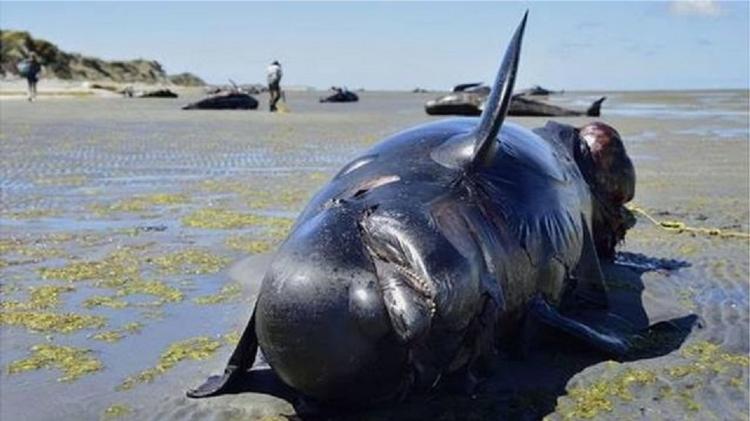Whale skeletons lie off the coast of Fuerteventura in the Canary Islands (Spain) as a grim reminder of the harmful effects of military sonar. Ship and submarine sonars are thought to be one of the factors that cause whales to run aground, confuse the animals’ own sonar, and head for the beaches.
But this technology, which is harmful to whales, may soon have a competitor.
Lori Adornato, project manager at the US military research agency Darpa, believes we can detect submarines if we pay more attention to natural sounds rather than just firing sonar pulses.
“We’re currently treating all these natural sounds as background noise or interference and we’re trying to change that,” says Adornato. “Why doesn’t he use these sounds and see if we can find a signal?”
His project, called Permanent Living Water Sensors (PALs), “listens” to marine animals as a way to detect underwater threats.
Current airborne sonar buoys? Developed by the military to detect underwater enemy activities? only work for a few hours in a small space due to limited battery life. The pulse system will be able to cover a large area for months.
It will be able to provide almost continuous monitoring of shorelines and underwater channels. Species that live on reefs and reliably stay in place will likely make the best sentries, Adornato says. “You have to make sure your body will always be there,” says the expert.
The Pals project is funding several teams to explore different research areas using very different reef-dwelling species.
black grouper
Laurent Cherubin of Florida Atlantic University in the United States is coordinating a team investigating the black grouper, a common fish in American waters, which can weigh up to 300 kg and is known for its loud vocalizations.
“It’s a loud sound, but at a low frequency,” explains Cherubin. “Black groupers are territorial and often make these sounds when they see an intruder in their area.”
The sounds this fish make can be detected from 800 meters away, but the goal isn’t always to fend off intruders and predators. Black groupers also make noises for mating, demarcating territories, and other purposes that still remain a mystery.
According to Cherubin, the team has now focused on alert calls to intruders, which is like trying to hear the barking of a guard dog. It’s not easy to distinguish these calls from the others, so the team created machine learning algorithms for this task. Thousands of records were required before the algorithms could distinguish and classify the different grouper calls.
The algorithm can then be turned into software running on a small but powerful processor built into an underwater microphone or hydrophone. A group of hydrophones can cover a reef, listen for grouper calls and track them as the cause of calls moves from one grouper area to another.
pistol shrimp
Analyzing conversations between fish may seem odd, but is Project Pals’ work at defense systems provider Raytheon too similar to conventional anti-submarine sonar? indeed, with one important difference.
“We’re trying to detect echoes when shrimp sounds are reflected by vehicles,” says Raytheon scientist Alison Laferriere. “It’s very similar to a conventional sonar system that detects echoes of sound produced by its source.”
In other words, the system works like any other regular sonar but uses shrimp-generated noise instead of artificial ones.
The pistol shrimp, also called the exploding shrimp, is known for making the loudest noise produced by any creature on Earth. 210 decibels (by comparison, the take-off of a jet plane produces 120 decibels).
This invertebrate closes its claws so quickly that it produces its characteristic crackle, producing enough sound energy to stun its prey.
Pistol shrimps also communicate with each other. A group of pistol shrimp emits a steady roar, which Laferriere compares to the sound of fried bacon.
“The signal created by a pistol shrimp has a very short duration and an incredibly wide amplitude,” says Laferriere. “A single crackle is much quieter than a conventional sonar source, but thousands of crackles per minute can be triggered.”
Laferriere explains that the sound varies with the time of day and the temperature of the water, but a shrimp colony is never quiet.
“One of the biggest challenges we face is dealing with the huge amount of noise created by the pistol shrimp and the environmental reverberations of all that noise,” Laferriere says.
Contrary to conventional sonar, these reflections are difficult to interpret as the source of the sound is unknown. Again the solution is to use modern software.
Laferriere’s team developed clever algorithms to analyze the sound and select a single click, first calculating the position of the shrimp, then the path of the reflected sound, and finally subtracting where it was reflected.
To understand the return noise, the Laferriere team needed to build computer models to determine which echoes were coming from background objects and could be ignored. Does the elimination of these echoes show objects moving in the environment? fish, submarines or unmanned underwater vehicles.
Once again, the ultimate solution will be a set of smart hydrophones with built-in computing that can process shrimp sounds and locate potential targets of interest in the area.
Other teams in the Pals project are doing similar work. Northrop Grumman researchers are working on another sonar system using shrimp, and a US Navy team is investigating the general sounds of the reefs and how intruders affect them.
All promise an enormous sensor network that will cover large areas over long periods of time, with most of the hardware suitably provided by nature. Only hydrophones will need repair or replacement.
Will it work?
“If the DARPA study is successful, it will be a really important innovation,” says Sidharth Kaushal, navy military equipment specialist at British think tank RUSI. “An ecosystem of sensors that live dispersed in perpetual fluctuation is attractive in principle.”
In principle, but not necessarily in practice. Kaushal has his doubts because previous projects using marine life to detect submarines have not been successful.
German submarines have been spotted for their effects on bioluminescent plankton, which emit a bright light when disturbed. and supposedly one of these submarines was sunk in the First World War thanks to this effect. But later attempts to exploit this phenomenon more widely, with specialized sensors looking for light sources over a wider area, met with little success.
“During the Cold War, Soviet and American efforts to use them systematically were futile,” says Kaushal. “Partly because there is no way to distinguish false positives from the real object, such as the response of a passing whale.”
For example, the nature of the distinction Pals might be able to make between a submarine and a shark is not yet known. Lori Adornato believes that the combination of marine organisms and modern smart algorithms will provide more traditional submarine hunters with a reliable “way warning” to check for a possible intruder.
Adornato says the technologies developed for the Pals project could also be used for scientific research, monitoring reefs and other underwater environments with an array of sensors.
“These low-impact observation systems can be developed in many different environments without harming the ecosystem that nature has created,” he says.
Adapting to the sounds produced by normal marine life and learning how they change will offer researchers an inexpensive and environmentally friendly way to monitor the impact of human activities underwater. This will be useful for projects like wind generators, oil extraction and deep sea underwater mining because all we have to do is listen to nature.
The project focuses on species common in US territorial waters, so their reproduction in other regions will not be easy. But overall the technology can be applied more broadly.
The Pals project has completed its first phase, a feasibility study for two different approaches to monitoring the responses of reef-dwelling species to intruders and gun shrimp sonar. The developers are now working on a second step to demonstrate how their solution works in controlled testing in the Northern Hemisphere in summer 2022.
Read the original version of this report (in English) on the BBC Future website.
‘This text was originally published at https://www.bbc.com/portuguese/geral-61918488’
source: Noticias
[author_name]


